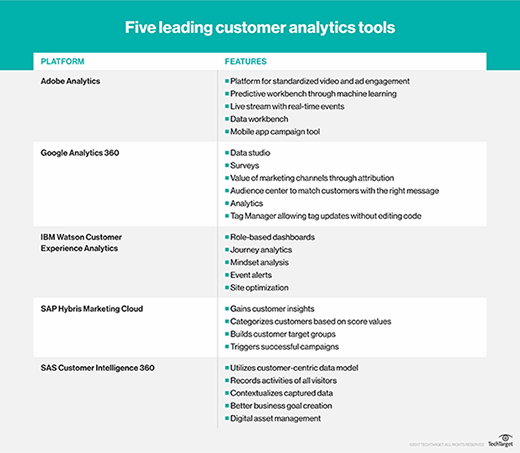Customer Analytics (customer data analytics)
Customer analytics, also called customer data analytics, is the systematic examination of a company’s customer information and customer behavior to identify, attract and retain the most profitable customers.
Why customer analytics matters
Customers have access to information anywhere, anytime including where to shop, what to buy, how much to pay and so on. This makes it increasingly important to utilize predictive analytics and data to forecast how customers will behave when interacting with brands.
The goal of customer analytics is to create a single, accurate view of a customer to make decisions about how best to acquire and retain customers, identify high-value customers and proactively interact with them. The better the understanding of a customer’s buying habits and lifestyle preferences, the more accurate predictive behaviors become and the better the customer journey becomes. Without large amounts of accurate data, any insight derived from analysis could be wildly inaccurate.
How to use customer analytics
Customer analytics is often managed by an interdisciplinary group made up of business owners from different departments within the company, including marketing, sales, customer service, IT and business analysts.
To be effective and obtain the most meaningful insights, the group must first agree upon which business metrics they need to achieve a single view of the customer experience. Multiple instances of customer relationship management (CRM) applications, disparate enterprise resource planning (ERP) systems and poor customer data integration (CDI) can leave group members with a fragmented view of the customer.

Customer analytics best practices
By measuring and analyzing data using specific metrics, organizations can create successful customer interactions. Some customer analytics best practices and common metrics that can help drive better business decisions include:
- Targeting customers across all channels and analyzing the various ways a product or service can be distributed.
- Assessing and understanding customers in relation to the brand and whether a customer is satisfied. This can be achieved through a combination of quantitative and qualitative surveys.
- Engaging with customers at the right moment through the right channel.
- Predicting churn rate and taking actions to extend a customer’s lifetime value.
- Spotting trends in big data and analyzing online behavior to increase sales.
- Maximizing the customer journey through personalized selling and market segmentation by assessing which customers might buy one type of product versus another.
Customer analytics tools
Customer analytics tools are specialized apps used to gain insight into the customer experience, understand customer behavior and to help tailor marketing campaigns to specific customer segments.
These customer data analysis tools can be part of a CRM suite or sold as stand-alone platforms which do everything from collect customer data from different systems in different locations (data integration) to data analysis and visualization. These tools also connect to popular sales and marketing applications along with web content management systems, email, social platforms and customer loyalty programs.
There are a number of customer analytics tools to choose from, provided by major CRM vendors and niche software providers. Tools from major vendors in this space include:
- Adobe Analytics
- Google Analytics 360
- IBM Watson Customer Experience Analytics
- SAP Hybris Marketing Cloud
- SAS Customer Intelligence 360
Some of the tools integrate features such as user segmentation with systems which personalize websites and that build niche marketing campaigns. As more customer analytics tools emerge, major software providers will likely improve usability further so their tools appeal to a wide range of users, and they’ll add integration and new services. In addition, advanced features will be built into connected systems, including omnichannel content management platforms.